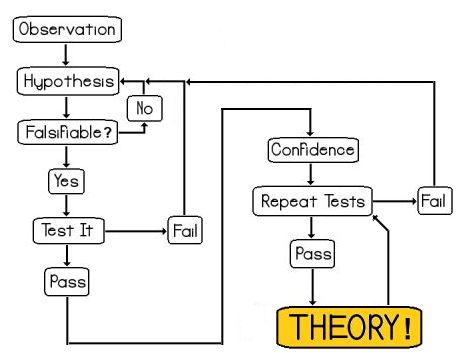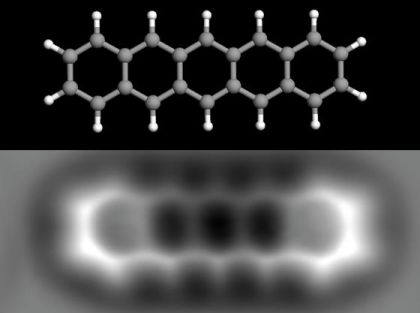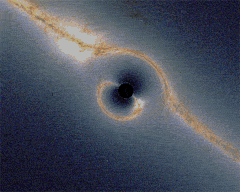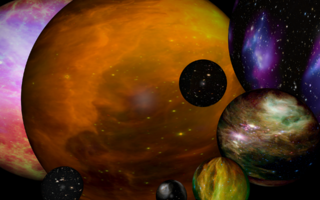![]()
Theoretically Speaking …
Ah, the weekend. You’re unwinding, watching a great classic movie like Bubba Ho-Tep.
But there’s something missing. You need a cat in your lap! You call her name, look around and mutter, “where did she get to …?”
… and a mouse toy comes rolling out from under the sofa. You grin. “Ah, hah!”
Now: at that moment, do you know for a fact that your cat is under the sofa? No. But based on previous observations of how the cat behaves, you’re pretty confident that she’s there.
Whether you realize it or not, you’ve just gotten a tiny taste of How Science Works. Read on.
 This example gives me an excuse
This example gives me an excuse
to show you my cat, Millie, again.
![]()
Disclaimer and Intro And Stuff
Wikipedia has a ton of stuff on the scientific method and scientific theories; click the links or do a Google search for enough detail to blow up your brain. This isn’t as cut and dried as I’m making it sound here. But the following will serve as a broad, general laycreature-level explanation of Science and How It Works.
Glance at the image at the top of this page. Whether your favorite branch of science follows that precise methodology, the key is the little “fail” boxes. Scientific theories cannot be proven; they can only be disproven.
We can (and do) have great confidence in theories that pass test after test, but as Stephen Hawking says in Brief History Of Time, there’s always a chance, however remote, that they’ll one day run up against a case that doesn’t match the predictions.
For my friends with a mathematical bent: don’t confuse this with your “mathematical theorems” and their “proofs.” Scientific theories are completely different. They’re predictive models.
Below is an example, courtesy of IBM. The top image is a pentacene molecule as predicted by theory. The bottom is the reality as imaged by Atomic Force Microscopy.
Theory meets reality, does lunch.
![]()
Popper’s Rules (Nothing To Do With Puffed Corn)
The bottom line is that a scientific theory is simply a model that describes or explains something. It makes predictions that can be tested (i.e., that are “falsifiable”).
Rules must be made by PhDs or politicians; in this case, a fellow named Karl Popper (a PhD, and not a politician) helped establish the rules for scientific theories. The essence is as follows:
- The thing being modeled must be observable.
- A scientific theory must provide a way in which it could be falsified.
- A scientific theory must adequately explain that which is already known about the thing that it’s modeling.
- The simplest theory which fits the facts is preferred (this is called “The Principle Of Economy”) and anything which is not absolutely required for that model to work should be cut out of the theory.
In spite of what some skeptics seem to believe, this works just as much for the Believer as against. It’s neither pro- nor anti-religion. It’s simply a strict methodology that helps explain things … with proven results.
Dr. Karl Popper. He considered hats
unfalsifiable, so he didn’t wear one.
![]()
The Peer Review Process
You’ve no doubt seen this term in any debate about origins; what is it?
Official Science(tm) — from formal proposals to new research to established theories — is published in dry, geeky things with names like Journal Of The Astro-Widget Society and Uber-Wokken Letters.
Getting an article (or a “paper,” if you’re a geek) published in one of these things is considered an accomplishment. Why? Because that paper will first have to be reviewed by your fellow scientists. If it doesn’t pass peer review, it gets tossed in File #13.
If you’ve ever read one of these papers, they’re as dry as stale toast, filled with brain-bending math and uber-geekery. They typically cover one subject (to death) and analyze it (to death). Unless you’re really into “Variation In The Symmetry Of The Cubic Faeces Of Vombatus Ursinus,” you’d probably find an old phone book considerably more exciting.
There’s a reason why scientists write popular books, or do interviews with magazines, or go on a television talk show, to discuss their beliefs about God, life, religion, morality and the proper thickness of pizza crust. These things don’t belong in the Official Gold Standard Reference(s).
Isaac Newton. If he was alive today,
he’d be fronting a nu-metal band.
![]()
A Scientific Theory: The Insane Pool Table
Let me show you how scientific theories are crafted and tested.
Someone has produced a crazy-looking pool table (see below). There’s a big black cover over the middle of it; I can’t see what’s under it. But when I shoot balls on the table, I observe that some don’t go where I expect.
Because I am a brilliant mad scientist, I hypothesize: there are bumpers under there that are deflecting the balls.
After shooting a bunch of balls all over the table, I further develop my hypothesis. “I propose,” I say loftily (and with a slight German accent), “that there are three round bumpers right here, here … and here.”
My faithful assistant, Igorina, (I AM an Equal Opportunity Employer, y’know) waddles over and marks the locations with dotted white circles. She also provides separate red, blue and green balls to make the test more colorful.
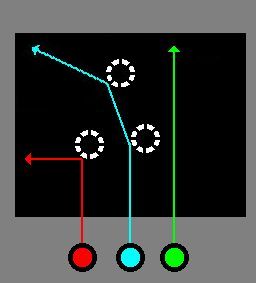
Like everything else, made in China.
![]()
The Proposal And First Tests
I make a formal proposal for how I’m going to test this. I’ll fire zillions of balls at different speeds and different angles, carefully recording where they emerge from under the black cover. I develop a coordinate system and keep careful records: “Ball number 1,232 was fired from point 12/36 at a speed of 1 meter per second; it emerged at point 12/4 at .98 meters per second.”
Yes, it can be that tedious. This takes a long time. Days — or weeks — or years.
This is where the stereotype of The Scientist Who Just Ain’t Quite … Right(tm) comes from: most of their research is BORING. Endless repetition, painstaking measurements, cross-referencing in computer databases, crunching numbers, and all while wearing a stylish white lab coat.
(Igorina wears gray with a fuzzy collar; she says it complements her slightly-off-center eyes.)
Not this kind of proposal.
![]()
Independent Replication
After a while, I am fairly confident that I know where those blasted bumpers are. I’m even confident that I know their shapes and sizes. I now write up my formal theory: “If you fire a ball from a given set of X/Y coordinates, this model will predict where they will emerge.”
I send this out to the rest of the scientific community for what’s called, “an independent replication of results.” Simply put, I want others to repeat my tests to see if I’m right.
(In this case, fortunately, some maniac in China is mass-producing these weird tables, so there are plenty to experiment with.)
Glance again at that flowchart at the top of this page. All it takes is for one test where the ball doesn’t go where my theory predicts and my model’s formula is falsified. Back to the drawing board. Remember: theories can never be “proven,” they can only be disproven.
If a theory withstands rigorous testing, it still hasn’t been “proven.” All that has happened is that confidence in my theory has increased.
Baba Yaga riding a pig and fighting The Crocodile Man.
I am confident that this doesn’t make a lick of sense.
![]()
Building Confidence
Each time a theory passes a test, confidence in that model is increased. Einstein’s Theory Of Relativity is a great example. Nowadays, we consider ol’ Albert a certified genius, but when he first published his “Theory of Invariance,” quite a few people were skeptical of it. He passed peer-review because he had his math in order, but that didn’t mean he was right.
We can translate one of his predictions into Laycreature-Speak: “if E=MC2 and so and so, then a beam of light can be ‘bent’ by gravity.” That’s clear, concise and objectively testable. This and other predictions were eventually confirmed by many experiments. Scientists then had confidence in Einstein’s theory as a valid model.
The animated GIF below is a simulation of what it might look like to head toward a black hole. The light behind the hole bends into what are called “Einstein Rings” due to the intense graviational field. It’d be absolutely spectacular … but there would be a small downside.
See, you’d be on a starship filled with (briefly) screaming people; the tidal forces would stretch everyone like naughty peasants in a medieval torture rack. Assuming you could even turn your head, right after you saw the silhouette of the hole, you’d be close enough to be ripped into a fine mist. The thin, flat cloud of particles that used to be you (and the ship) (and your fellow passengers) would emit some gamma rays and stream into the hole at nearly the speed of light, lost behind the Swarzchild radius.
But it would be spectacular. Briefly.
![]()
Models And Sub-Models
“Evolution keeps changing … which theory is right? Punctured Lubrication or Class-sized Graduations?”
No. Just … NO.
A theory is just a model. There may be more than one model to help describe something, or (more commonly) you may have One Big Overall Model that consists of, or contains, a bunch of smaller models.
For example, the basic, bottom line Big Bang Theory just says that the universe started small and expanded to its present size. The most-accepted variant right now is the Inflationary Big Bang.
As proof that the popular media don’t get this, you’ll see headlines that blare, “Standard Big Bang Replaced By New Theory!” As you read the article, though, you’ll see that physicists have simply tweaked the theory and have improved some things. This happens all the time in science.
Pictured: punctured lubrication.
![]()
The Models Change And Improve
Newton’s math for gravity and motion isn’t perfect, but it’s close enough for most work. For really precision stuff, though, scientists will lean toward Einstein (and others), because the newer theories are more accurate and cover some cases that Newton missed. This, too, is a normal function of science.
Some theories seem to work for a while, but eventually run into something that they can’t explain. When that happens, scientists will warn that the theory has problems in these certain cases. They’ll then modify that theory, or come up with a new theory, to better model things.
This doesn’t mean they were “wrong” (anymore than Newton was “wrong”); it just means they know more and have improved the theory(ies) to fit. This is a perfectly normal function of science and it occurs all the time.
For example, an electron will act like a tiny, statically-charged ball bearing in some cases. In others, it acts like a “smeared” wave. (This is the old Wave-Particle Duality, for those of you who like fancy terms.) Someone may eventually craft a new theory that explains this more intuitively. But for now, the models are good enough for the microprocessors that let you read this.
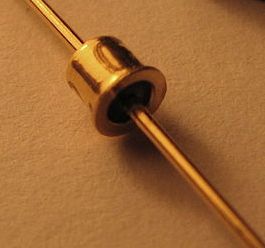
The 1N3716 uses Quantum Tunneling.
But not if you let the smoke out.
![]()
For My Fellow Believers
This is why miracles have no place in science. You may think that scientists are opposed to the miraculous by nature. Sure, some of them are (they’re human), but many aren’t. There are plenty of Believers in science (much to the annoyance of hardcore atheists who are convinced that only people who flatly reject the existence of God can truly be “objective”).
But look at the flowchart at the top of this page one more time. Now, tell me how you’re going to formally test the idea that, “I prayed for God to heal my cold and He did, hallelujah!” Hey, I might believe you, but that would be something I would take on faith. I can’t disprove that God healed your cold. See how this works?
Scientists also need repeatability: if you pray for your neighbor today and he is healed, they want you to be able to pray for someone else tomorrow and have the same exact thing happen, on demand.
Most of us know at least one amazing story, often told by a doctor, of the patient that wasn’t expected to live, but who “mysteriously” got better. But again: how would science objectively and repeatably measure this?
Pictured: objective measurements.
![]()
Radiometric Dating And The Age Of The Earth
This is also for my fellow Believers. I gain no pleasure for saying this, but it needs to be said.
Simply put: many of the arguments from groups like the Institute For Creation Research (the good ol’ ICR) are flawed. Nowhere is this more true that in their rejection of radiometric dating, so that’ll be my example.
But you should know, my fellow Believers, that virtually every point ever made by the ICR and Answers in Genesis (AIG) has been addressed. At length. Even if you disagree, let me warn you: don’t waste your time using ICR or AIG answers in an online debate with a skeptic. They’re ready for you and will give you Web links that will refute every single claim.
This includes virtually the entire litany: “if the Earth was that old, everything would have eroded and the seas would be full of sediment by now” and, “Canyon Lake Gorge in Texas formed in a few days — this proves that the Grand Canyon didn’t need millions of years!”

What a canyon might look like.
![]()
For myself, I decided years ago that the “days” of Genesis were very long periods of time, especially after I realized that it was an eyewitness account. (More on this later, too.) In their determination to “prove” that the Earth is less than 50,000 years old, Young Earth Creationists are not only engaging in bad science and ruining their credibility, they’re taking away one of my most effective witnessing tools for non-believers (as you’ll see later).
I also have to say this. What really irks non-believing scientists is the claim that they secretly “know” that “radioactive dating” is bogus, but cling to it solely because they won’t believe in God.
First, there are plenty of Believers (some quite conservative and Bible-believing ones, like yours truly) who have no problem with an “old” Earth. Some of them work in science and even use these methods themselves! Are they part of the “conspiracy?”
Second, what you’re really doing is, you’re accusing these scientists of intellectual dishonesty, shoddy work or worse. For some reason, that offends them. (Go figure.)
There is great confidence in these methods nowadays. They’ve been refined for many, many years, too. What most laycreatures also don’t know is that, when scientists date something, they don’t just use one method nowadays, either. They’ll sanity-check themselves whenever possible by comparing the results from as many different methods as they can use.

Thermoluminescence is prettier
than radiometric dating, too.
![]()
The Key Point!
Believers have nothing to fear from science … provided it follows its own rules fairly.
I said that I would show you that either this universe is designed, or it’s just one of many. This is so important, I’m going to put it in bold text: both viewpoints (especially at present) require faith, because neither can be “proven” (either literally or in the scientific sense of “confidence” in a robust theory). You can certainly argue that your “belief” is better than mine, but at the end of the day, that’s all it is.
Many atheists will say, “religious people believe in that which can’t be seen or reliably demonstrated; rational people believe only in that which can be demonstrated.” I wish it were that clear-cut, but OK, let’s take that at face value. One day I will see that in which I believe; you believe in what you can see now. (Except for multiverses. And a few zillion other things. But hey; I said I’d take it at face value.)
That’s your choice and I’ll defend your right to it. But at the end of the day, it’s still faith.
I’m not a philosopher and frankly, I would rather watch paint dry than to start debating semantics and parsing terms. (Nothing makes a Creationist happier than quoting scientists, and nothing better pleases an Atheist than pulling out a dictionary and parsing terms like “belief” for hours on end. You have been solemnly warned. In both cases.)
If you disagree with that, fine. If you want to argue, I won’t be here. I’m headed toward the next section. But first …
The guy who tested this example
of Unintelligent Design is dead.
![]()
A Final Thought About Multiverses
Paul Davies has a good discussion about what scientists believe in the Appendix to Cosmic Jackpot. There is indeed a strong consensus that this universe appears to have been designed for the emergence of carbon-based life, but there are differing opinions about what it means.
According to him, most scientists just choose not to think about it: they get on with the business of digging and observing and crunching numbers, perfectly satisfied to leave it as a mystery that doesn’t affect them (or their work) personally.
Other scientists, says Davies (especially String/M-Theorists), believe that a set of laws and principles will eventually be discovered to explain the design: a Grand Unification-ated And Splendid Theory of Everything will cover it all. Davies himself believes something subtly different: he thinks that a “Life Principle” or something like it is responsible for intelligent beings like you and I.
But there is a growing consensus for the multiple universes (multiverse) idea: our cosmos is just one of zillions, and is one of the “lucky” ones. Somewhere out there, far beyond our ability to see, is a vast array of realms that are either cold and dead, or unthinkably hot and dead. Of course our cosmos looks designed, but then it would, wouldn’t it?
Remember the Principle of Economy (see Popper’s Rules above). For me to accept the concept of multiple universes, scientists will have to show me that they have a thoroughly-tested, robust and falsifiable theory that absolutely requires these other realms to explain what we see in our realm. I don’t think they can do that.
An image from Wikipedia’s article on multiverses.
Apparently, these other realms are quite colorful.
Click here to continue with a look at Watchmakers and hats, or use the menu to the left.

